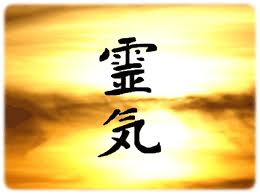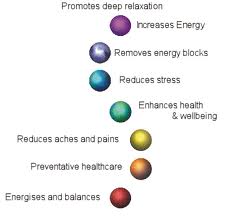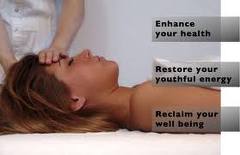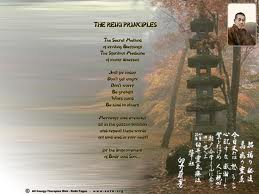FREQUENTLY ASKED QUESTIONS ABOUT REIKI

WHAT CAN REIKI DO?
This list has been comprised through anecdotal research. Clients have reported feeling:
- More creative
- More balanced
- Less emotional
- Less stressed
- More relaxed
- More vitality
- More awareness
- Less or no pain
- More ability to fall asleep quickly
- More ease of movement
These reported benefits generally lasted at least three to ten days, and often the original problem did not re-occur.

WHAT CAN REIKI DO?
This list has been comprised through anecdotal research. Clients have reported feeling:
- More creative
- More balanced
- Less emotional
- Less stressed
- More relaxed
- More vitality
- More awareness
- Less or no pain
- More ability to fall asleep quickly
- More ease of movement
These reported benefits generally lasted at least three to ten days, and often the original problem did not re-occur.

This list has been comprised through anecdotal research. Clients have reported feeling:
- More creative
- More balanced
- Less emotional
- Less stressed
- More relaxed
- More vitality
- More awareness
- Less or no pain
- More ability to fall asleep quickly
- More ease of movement
These reported benefits generally lasted at least three to ten days, and often the original problem did not re-occur.

WHAT HAPPENS DURING A SESSION?
The client, fully clothed, lies on the treatment table. The practitioner's hands remain in a stationary position, gently on or slightly above the body through several positions from head to toe. Some practitioners do not use the prescribed hand positions, preferring to use a more intuitive approach. The private areas are worked on 4-6” above the body. There is no manipulation of the skin or tissue. Reiki is not massage.
Many individuals report feeling cold, pulsating heat, or a tingling sensation during a session, and most enter a calm, relaxed state. In some, chronic or acute pain can diminish or completely vanish. Sometimes allergies and other infirmities completely disappear. It's different for each person.
It's important to remember that, whatever is troubling us, 'we didn't get this way overnight’ and we won't 'recover overnight’, either. Reiki is not any more magical than any other modality or allopathic medicine. Healing takes commitment and it takes time... one moment at a time.
WHAT CAN BE EXPECTED AFTER A SESSION?
Directly after a Reiki session, you should allow yourself time to come fully back into your awareness. You may feel so relaxed that you are spaced-out. It is suggested to sit for 15 minutes and sip a cool glass of purified water. Becoming in touch with the soles of your feet and their placement on the floor also helps a great deal.
Over the next little while, you may notice that you are de-toxifying the waste that has built up in your system. You may want to allow more time in the ‘little room’ (the washroom) in the morning. You should increase your water and/or herbal tea intake so that the toxins are flushed out more readily. You may want to rest more, so allow time for that.
Most people feel an immediate improvement in their level of pain. Energy and alertness increase daily and a feeling of overall well being may be noticed.
HOW MANY SESSIONS DO I NEED?
To begin with, three or four sessions over ten to fourteen days are recommended to remove entrenched blocks in your energy system; then once a week or once every two weeks until the issue has resolved. You will begin to notice some improvement after the first session. Long-standing health issues are usually cleared up in five to six visits. Dis-ease generally begins in the energy field so if we keep our subtle bodies healthy using Reiki, and our physical bodies healthy with good nutrition and exercise, we should be able to remain active and whole.
HOW IS REIKI A HOLISTIC APPROACH TO MY WELL BEING?
It is strongly recommended that you do not discontinue any medications or session plan your medical practitioner or other holistic healer has deemed necessary, unless you first speak with them personally. Reiki energy works in concert with all other forms of therapy. It is a wonderful complement to other treatments. We can all work together to get you feeling healthier, happier and more whole. This is the holistic approach.
The Reiki energy goes to exactly where it is needed so a Reiki Practitioner never needs to diagnose nor prescribe – nor does ethics or law allow them to.
WHAT IS THE USUI SYSTEM OF NATURAL HEALING?
The word Reiki (pronounced Ray-Key) is a Japanese kanji for universal life-force energy.
Reiki is a Japanese holistic, light-touch, energy-based modality. Working as a support mechanism to the body, Reiki re-establishes a normal energy flow of ki (life force energy) throughout the system, which in turn can enhance and accelerate the body's innate healing ability. Through a series of hand positions either directly on or just above the body, the energy worker allows for the flow of energy through their body. The client’s body then draws off the amount of energy that is required. The simplicity of a Reiki session may raise some skepticism, however, after experiencing it, many clients keep coming back for more of those relaxing feelings.
Reiki is simple and produces measurable results. It is power, light and love. Reiki transcends the man-made divisions of religion, economics, location, gender, and race.
WHAT ARE THE FIVE PRINCIPLES OF REIKI?
They offer a simple guideline for daily conduct with others and self. They are:
Just for today, I will not anger Just for today, I will not worry Just for today, I will be grateful Just for today, I will work hard on myself Just for today, I will be kind to others
WHAT IS REIKI TRAINING ALL ABOUT? GENERALLY SPEAKING...
The focus of Level One is on self-healing and helping others. After the student completes the required training, which may take one to four days, they are able to practice Reiki and do self-healings. At this level, the student learns the history of Reiki, the energy system, the nature of the Reiki energy, the Reiki Ethics, the five principles or precepts, the three pillars of Reiki, the hand positions, how to do a self-healing and how to provide a session for others.
At Level Two, the focus is on learning the Japanese healing symbols and on sending Reiki from a distance (we must always get permission to send a distant healing). It is suggested that a student wait at least 21 days so that level one can be properly instilled and grounded within the student.
There is an in-depth discussion on clearing unwanted habits, empowering personal goals, and manifesting permanent change in the student’s life. The Japanese healing techniques are introduced and practiced. Distant sending is practiced.
Level Three: In some lineages, the levels of training are taught in four instead of three sessions. This level can include meditation techniques, a Healing Attunement, the Hui Yin, the Violet Breath, Aura Clearing, and Reiki Crystal Grids. The Master symbol is given but the student is not taught how to attune others or teach Reiki.
Level Three Master/Teacher: Here, the focus is on attuning others to the Reiki energy and on teaching Reiki to others. An essay is written on why the student wishes to become a Reiki Master/Teacher. It is discussed at length. The master symbol is introduced and practiced. The benefits of living a spirit-based life are discussed, as well.
WHAT DOES THE TERM REIKI MASTER MEAN?
In Reiki, master means teacher. Master also means that the student has come far enough along in his or her development that troublesome lifestyle habits and limiting belief systems are taking less and less time and energy away from living a fully conscious life.
A Master has taken the responsibility to become Master of himself or herself. It is not a designation used for ego inflation or to manipulate others.
One does not have to base their life on spiritual practices to be a Reiki Master. Everyone has his or her own belief system and is quite free to maintain it and still be considered a Reiki Master. The mastery is in dealing with oneself so that one is able to stay in his or her own energy and not interfere with the path of another being.
Master Lineage
Usui ~ Hayashi ~ Takata ~ Ishikuro ~ Robertson ~ Boddie ~ Nelson ~ Laidlaw

